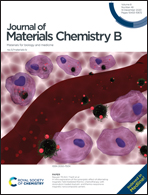Efficient near-infrared anionic conjugated polyelectrolyte for photothermal therapy†
Abstract
In this work, an anionic conjugated polyelectrolyte (PCP-SO3K), in which the backbone contains alternating 4,4-bis-alkyl-4H-cyclopenta-[2,1-b;3,4-b′]-dithiophene and benzene structural units and the charges are provided by pendant sulfonate groups, was synthesized. The ionic nature of PCP-SO3K renders it soluble in water, and PCP-SO3K aqueous solution exhibits good photostability, with two main absorbance bands centered at 490 nm and 837 nm before and after laser irradiation. Its NIR absorption in water, negligible photoluminescence and insignificant intersystem crossing endow PCP-SO3K with efficient photothermal therapy performance, and an effective photothermal conversion efficiency of 56.7% was realized. Thus, PCP-SO3K aqueous solution can be used as an effective photothermal agent for in vivo applications as its photoactivity can be triggered by NIR light and can convert laser energy into thermal energy in a water environment. Of particular importance is the fact that complete tumor remission without recurrence in 4T1 tumor-bearing mice was realized after intravenous injection of PCP-SO3K aqueous solution and laser irradiation (2.0 W cm−2, 808 nm). The results indicate that the application of anionic conjugated polyelectrolytes as photothermal agents in photothermal therapy provides a new platform for the design of photothermal agents for clinical cancer treatment.



 Please wait while we load your content...
Please wait while we load your content...